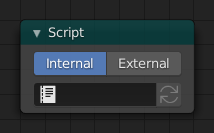オープン・シェーディング言語¶
Cycles Only
オープン・シェーディング言語 (以下 OSL) を用いることで独自のノードを作ることができます。そうして作成したノードは CPU を用いたレンダリングでしか動作しないことに注意して下さい; GPU 上での OSL コードの処理はサポートされていません。
この機能を利用するには、レンダリング設定でシェーティングシステムとして Open Shading Language を選択して下さい。
Script (スクリプト)ノード¶

Script ノード。¶
OSL was designed for node-based shading, and each OSL shader corresponds to one node in a node setup. To add an OSL shader, add a script node and link it to a text data-block or an external file. Input and output sockets will be created from the shader parameters on clicking the update button in the Node or the Text editor.
OSL シェーダーはノードに対して幾つかの異なる方法でリンクされます。 Internal (内部)モードでは、OSL シェーダーを保存するためにテキストデータブロックが使われ、OSO バイトコードはノード自体に保存されます。この方法は全てを内蔵した物として blend ファイルを配布する場合に便利です。
External (外部)モードではハードディスク上の .osl ファイルを選択して利用し、同じディレクトリに自動的に .oso ファイルにコンパイルされた結果が保存されます。ユーザーによって手動でコンパイルされた .oso ファイルのパスを指定することもでき、その場合は直接利用されます。三番目の選択肢は、シェーダーの探索対象パスを検索するのに用いるモジュール名を直接指定するだけです。
シェーダーの探索対象パスは記述したスクリプトと同じ場所および、以下のあらかじめ設定されたパスとなります:
- Linux
$HOME/.config/blender/2.83/shaders/
- Windows
C:\Users\$user\AppData\Roaming\Blender Foundation\Blender\2.83\shaders\
- macOS
/Users/$USER/Library/Application Support/Blender/2.83/shaders/
ちなみに
プロダクション環境での利用のため、シェーダーの Script ノードを分類するノードグループを利用し、他の blend ファイルにリンクさせる事を推奨します。この方法では全てのファイルの Script ノードを更新する事無く、入出力ソケットが追加もしくは削除された後もノードに対する変更を容易なものにします。
シェーダーを記述する¶
どのようにしてシェーダーを記述するかについての詳細は、OSL 仕様書 を参照下さい。ここでは以下に簡単な例を示します:
shader simple_material(
color Diffuse_Color = color(0.6, 0.8, 0.6),
float Noise_Factor = 0.5,
output closure color BSDF = diffuse(N))
{
color material_color = Diffuse_Color * mix(1.0, noise(P * 10.0), Noise_Factor);
BSDF = material_color * diffuse(N);
}
クロージャ¶
OSL is different from, for example, RSL or GLSL, in that it does not have a light loop. There is no access to lights in the scene, and the material must be built from closures that are implemented in the renderer itself. This is more limited, but also makes it possible for the renderer to do optimizations and ensure all shaders can be importance sampled.
The available closures in Cycles correspond to the shader nodes and their sockets; for more details on what they do and the meaning of the parameters, see the shader nodes manual.
BSDF¶
diffuse(N)oren_nayar(N, roughness)diffuse_ramp(N, colors[8])phong_ramp(N, exponent, colors[8])diffuse_toon(N, size, smooth)glossy_toon(N, size, smooth)translucent(N)reflection(N)refraction(N, ior)transparent()microfacet_ggx(N, roughness)microfacet_ggx_aniso(N, T, ax, ay)microfacet_ggx_refraction(N, roughness, ior)microfacet_beckmann(N, roughness)microfacet_beckmann_aniso(N, T, ax, ay)microfacet_beckmann_refraction(N, roughness, ior)ashikhmin_shirley(N, T, ax, ay)ashikhmin_velvet(N, roughness)
Hair¶
hair_reflection(N, roughnessu, roughnessv, T, offset)hair_transmission(N, roughnessu, roughnessv, T, offset)principled_hair(N, absorption, roughness, radial_roughness, coat, offset, IOR)
BSSRDF (双方向散乱面反射率分布関数)¶
bssrdf_cubic(N, radius, texture_blur, sharpness)bssrdf_gaussian(N, radius, texture_blur)
ボリューム¶
henyey_greenstein(g)absorption()
その他¶
emission()ambient_occlusion()holdout()background()
付録¶
Some object, particle and mesh attributes are available to the built-in getattribute() function.
UV maps and vertex colors can be retrieved using their name.
Other attributes are listed below:
geom:generatedGenerated のテクスチャ座標系。
geom:uvデフォルトで出力される UV マップ。
geom:dupli_generatedインスタンス生成されたオブジェクトについて、複製元オブジェクトの Generated 座標系。
geom:dupli_uvインスタンス生成されたオブジェクトについて、複製元オブジェクトの UV 座標系。
geom:trianglevertices三角形を形成する 3 頂点。
geom:numpolyverticesポリゴンを形成する頂点の数(現在 3 を常に返します)。
geom:polyverticesポリゴンを形成する頂点の座標系の配列 (現在は常に 3 頂点を対象とします)。
geom:nameオブジェクトの名称。
geom:is_curveオブジェクトが Strand (ストランド)であるか否かを返します。
geom:curve_interceptストランドを、根本から先端まで、形成する点を返します。
geom:curve_thicknessストランドの厚みを返します。
geom:curve_tangent_normalストランドの Tangent 法線。
path:ray_length最後に衝突してからの光線の距離。
object:locationオブジェクトの位置。
object:indexオブジェクトのインデックス番号。
object:randomオブジェクトのインデックス番号と名前から生成される、オブジェクトを通してランダムな番号。
material:indexマテリアルのインデックス番号。
particle:indexパーティクルのインスタンス番号。
particle:ageフレームにおけるパーティクルエージ。
particle:lifetimeフレームにおける総表示時間。
particle:locationパーティクルの位置。
particle:sizeパーティクルの大きさ。
particle:velocityパーティクルの速度。
particle:angular_velocityパーティクルの角速度。
Trace (トレース)¶
私達は OSL シェーダーからの光線をトレースできるよう、trace(point pos, vector dir, ...) 関数をサポートしています。現時点では "shade" パラメータはサポートされていませんが、衝突したオブジェクトの属性値は getmessage("trace", ..) 関数を用いることで取得できます。どのようにこの機能を用いるかに関する詳細は OSL 仕様書を参照下さい。
この機能はライティングの代替として利用できる物ではありません;主な目的はシェーダーに、例えば立体に遮蔽されうる投影テクスチャを適用したり、露出した立体をより "摩耗させ" たりする等その他アンビエントオクルージョンのような効果を作り、近接した立体を "検知させる" 事です。